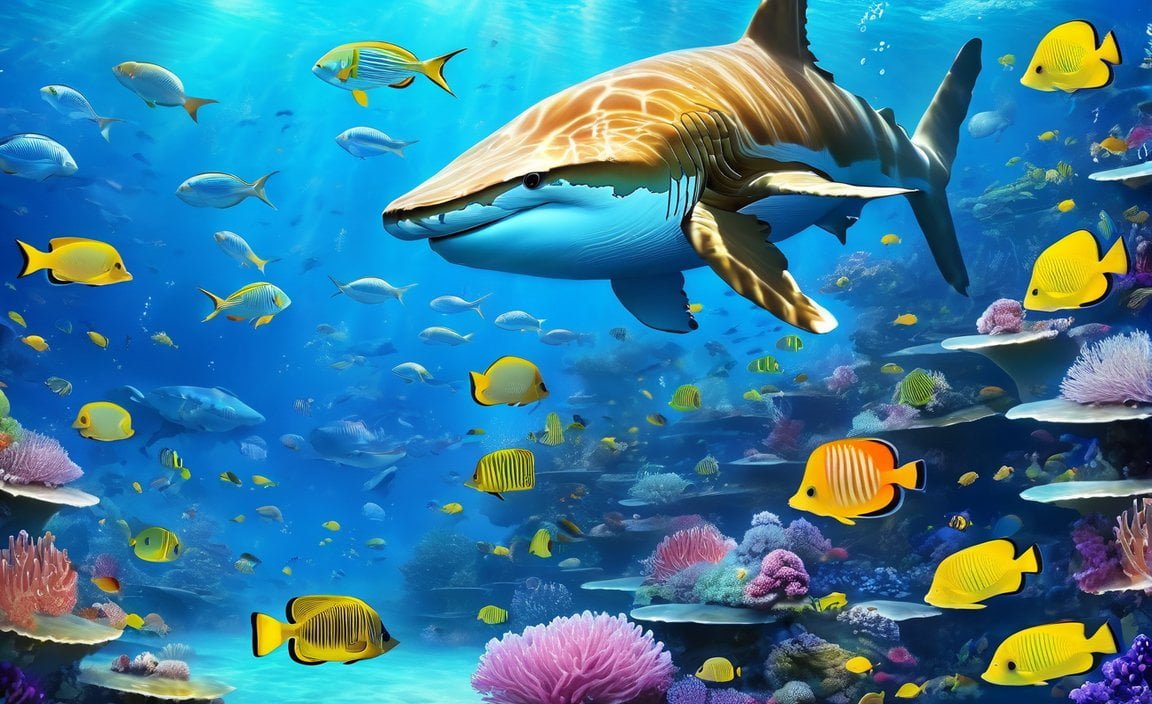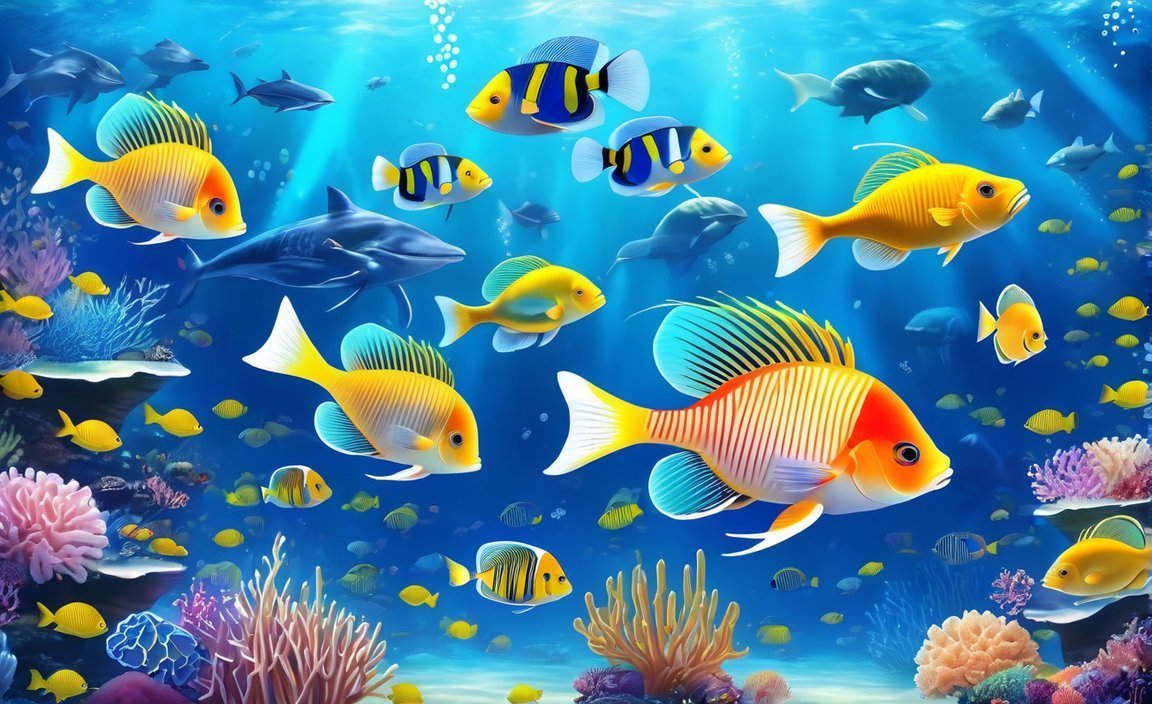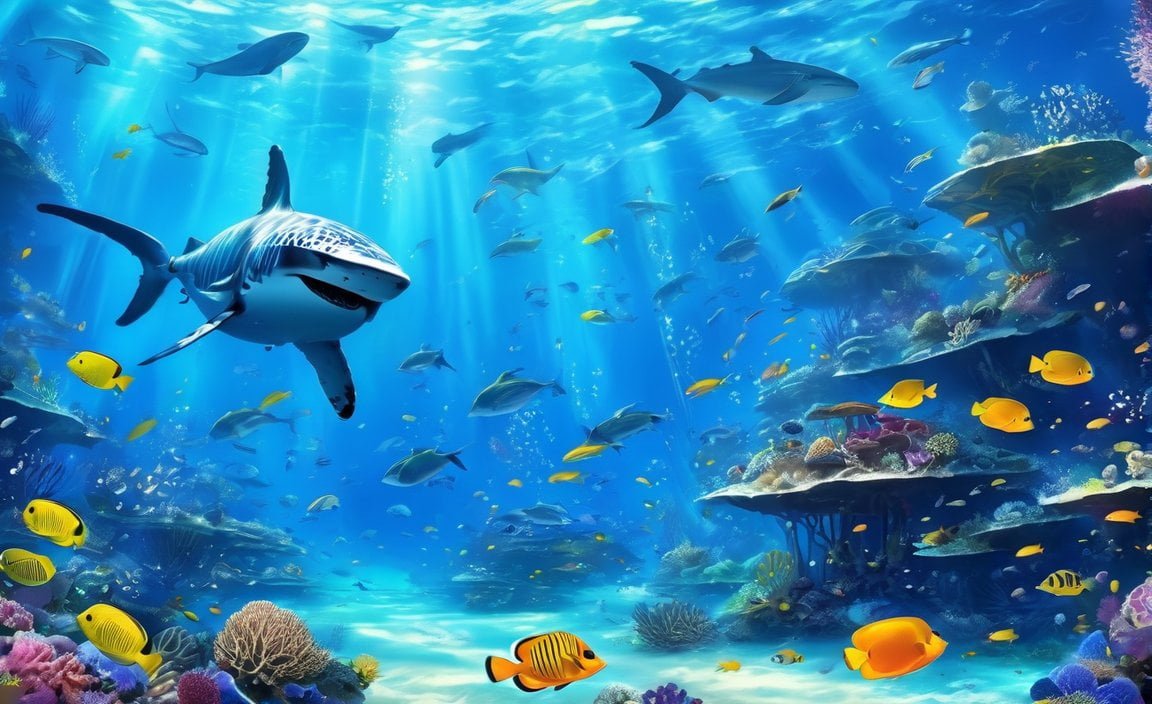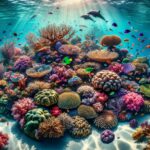Unveiling the Wonders: 10 Intriguing Marine Biology Facts invites you to dive into the depths of the ocean and explore the fascinating world of marine biology. In this captivating article, we will delve into ten captivating facts that shed light on the marvels of marine life. From the intricacies of coral reefs to the incredible adaptations of deep-sea creatures, prepare to be amazed by the wonders that await beneath the surface of our vast oceans.

Key Takeaways:
- There are approximately 10,000 marine biologists worldwide, studying various aspects of marine life.
- Marine biologists spend about 60% of their time in the field, collecting data and conducting research.
- Over 90% of the ocean remains unexplored by humans, emphasizing its vastness and mysterious nature.
- Advanced technologies like remotely operated vehicles (ROVs) enable scientists to study the deep sea.
- Small sea turtles have the remarkable ability to actively swim and orient themselves in ocean currents.
- Expanding no-fishing zones has helped coral trout populations recover in the Great Barrier Reef.
- Larval fish communicate with each other using sounds, enabling navigation and social bonding.
- Cephalopods like octopuses and squids alter their RNA to adapt to different environments.
- Puffer fish can inflate and deflate their bodies for defense and camouflage.
- Recent research has used UV light to uncover the true colors of ancient seashells, revealing insights into marine life’s evolution.
10 Interesting Facts about Marine Biology
Marine biology is a captivating field that delves into the intricate world of ocean life. In this article, we will explore ten intriguing facts about marine biology that will leave you in awe of the wonders lurking beneath the waves.
Fact 1: The Enigmatic Army of Marine Biologists
Did you know that there are approximately 10,000 marine biologists across the globe? These dedicated scientists focus on studying the ecology, conservation, physiology, and genetics of marine organisms, unraveling the secrets of the vast oceanic realm^1^.
Fact 2: A Journey into the Field
Marine biologists immerse themselves in the great blue expanse, spending an average of 60% of their time in the field. Armed with research tools, they collect invaluable data to further our understanding of marine ecosystems^2^.
Fact 3: The Depths of Discovery
Over 90% of the ocean remains unexplored by humans, shrouded in mystery and beckoning us to uncover its secrets. It’s a constant reminder of the boundless wonders waiting beneath the surface^2^.
Fact 4: Technology Unveiling the Deep
Remotely operated vehicles (ROVs) and submersibles play a pivotal role in marine biology exploration. These advanced technologies allow scientists to explore the enigmatic depths of the ocean, leading to extraordinary discoveries that were once inaccessible to humans^2^.
Fact 5: The Incredible Journey of Small Sea Turtles
Small sea turtles possess an exceptional ability to actively swim and orient themselves in ocean currents. It’s a remarkable adaptation that helps them navigate the vastness of the sea and embark on incredible journeys^1^.
Fact 6: Protecting the Crown Jewel of the Ocean
Expanding no-fishing zones has proven instrumental in the recovery of coral trout populations in the Great Barrier Reef. This conservation effort aids in preserving the delicate balance of this majestic ecosystem^1^.
Fact 7: Whispers in the Underwater World
Larval fish amaze us with their ability to communicate through sounds, creating a unique language that allows them to navigate and form social bonds. It’s a captivating symphony unfolding beneath the waves^1^.
Fact 8: The Shapeshifting Masters of Adaptation
Cephalopods, such as octopuses and squids, possess an astonishing ability to alter their RNA to adapt to different environments. This remarkable trait showcases their incredible adaptability and survival skills in diverse marine habitats^1^.
Fact 9: The Puffer Fish’s Ingenious Defense
Puffer fish have a fascinating defense mechanism. Rather than holding their breath, they can inflate and deflate their bodies by pumping water or air, leaving predators baffled and ensuring their own safety in the vast ocean^1^.
Fact 10: Illuminating Ancient Seashells
Recent research has uncovered the true colors of ancient seashells through the use of UV light, shedding light on the evolution and history of marine life. This breakthrough serves as a testament to the continuous expansion of our understanding of the ocean^2^.
These ten intriguing facts about marine biology offer a glimpse into the astonishing diversity, adaptability, and captivating secrets that lie within our oceans. They remind us of the critical role marine biology plays in conserving and protecting our fragile aquatic ecosystems while evoking a sense of wonder and awe for the magnificent world beneath the waves.
Sources:
Here are 10 interesting facts about biomes that will leave you amazed!
Ready to explore the wonders of biomes? Check out these fascinating 10 interesting facts about biomes.
Dive into the intriguing world of biomes with these 10 captivating facts that will blow your mind!
Curious about the diverse ecosystems on our planet? Discover 10 intriguing facts about biomes that will leave you in awe.
Embark on a journey through the incredible world of biomes by uncovering these 10 mind-boggling facts that will leave you wanting more.
Experience the beauty and complexity of biomes through these 10 astonishing facts that will leave you speechless.
Brace yourself for an adventure into the realm of biomes as you explore these 10 mind-blowing and eye-opening facts.
Unveil the secrets of biomes by delving into these 10 mesmerizing facts that will leave you in awe of the natural world.
Get ready to be amazed! Discover 10 fascinating facts about biomes that will challenge everything you thought you knew about ecosystems.
Are you curious about the wonders of biomes? Explore these 10 mind-bending facts and be prepared to have your mind blown.
Step into the extraordinary world of biomes with these 10 intriguing facts that will ignite your curiosity and thirst for knowledge.
Don’t miss out on learning more about biomes by clicking on this link: 10 interesting facts about biomes
3. Deep-sea marvels: Exploring the fascinating adaptations of organisms living in the extreme conditions of the deep ocean.
The deep sea is a mysterious realm that covers more than two-thirds of our planet, harboring countless marvels and undiscovered treasures. In this article, we’ll delve into the fascinating adaptations of organisms living in the extreme conditions of the deep ocean. Join me on this journey as we unravel the secrets of the deep.
The Depths of Exploration
The deep sea, with its abyssal depths and remote locations, remains largely unexplored by humans. Yet, researchers have made remarkable discoveries that shed light on the extraordinary adaptations of organisms thriving in this harsh environment.
Life in the Cold
One of the most intriguing deep-sea habitats is found beneath the permanent ice cover in Antarctica. Surprisingly, sessile animals similar to sponges have adapted to survive in this frozen world. These organisms showcase nature’s resilience and the incredible ability of life to adapt to even the most extreme conditions.
Altered by Human Activities
Human activities, such as mining, have not only impacted the surface of the Earth but also altered deep-sea biology. Changes in fish populations have been observed due to disturbances caused by mining operations. This highlights the interconnectedness of our actions on land and the delicate balance of deep-sea ecosystems.
Survival Strategies
Organisms in the deep sea have evolved diverse strategies for survival. Some rely on scavenging, feeding on the nutrient-rich organic material that sinks from the surface. Others are adept predators, catching their prey in the deep darkness. There are also filter feeders, organisms that extract their sustenance from the water column. These various feeding methods underline the adaptability and resourcefulness of deep-sea organisms.
A Microbial Haven
While microbes dominate the deep-sea ecosystem in terms of abundance and biomass, complex multicellular life forms also thrive at all depths. This includes majestic creatures like large shark species. The intricate balance between microorganisms and higher-order organisms in the deep sea highlights the interconnectedness of life in this vast ecosystem.
The Largest Biome on Earth
The deep sea is the largest biome on Earth, covering an extensive 326 million km² of the deep seafloor. Despite its immense size, our knowledge of its organisms remains limited. The exploration of this vast habitat presents an exciting opportunity to uncover countless more deep-sea marvels.
The Extremes Within
Extreme environments within the deep sea house unique and diverse microbial communities. Deep-sea hydrothermal vents, glaciers, and permafrost are just a few examples of these extreme habitats. These communities have adapted to thrive in conditions where most life cannot survive, offering valuable insights into the limits of life on Earth.
Coral Adaptations
Even at abyssal depths, deep-sea corals can be found, showcasing their remarkable adaptations to survive in low-light conditions. These corals, like their shallow-water counterparts, form intricate structures that provide habitats for numerous other organisms. Understanding the adaptations of deep-sea corals can help us conserve and protect these fragile ecosystems.
Unique and Adapted
The deep sea encompasses over 95% of Earth’s living space and is home to a vast array of unique and adapted marine organisms. These organisms have evolved through countless generations to survive and thrive in the challenging conditions the deep sea presents. Their resilience and ingenuity inspire awe and admiration.
Key Takeaways:
- The deep sea, covering over two-thirds of the planet, remains largely unexplored by humans.
- Organisms living in extreme deep-sea environments have evolved fascinating adaptations to survive.
- Human activities, such as mining, have impacted deep-sea biology and altered fish populations.
- Deep-sea organisms utilize various feeding methods, including scavenging, predation, and filtration.
- Microbes dominate the deep-sea ecosystem but coexist with complex multicellular organisms.
- The deep sea is the largest biome on Earth, yet our knowledge of its organisms is limited.
- Extreme environments in the deep sea harbor diverse microbial communities that thrive under extreme conditions.
- Deep-sea corals have adapted to survive in low-light conditions at abyssal depths.
- The deep sea is home to a remarkable array of unique and adapted marine organisms, showcasing nature’s ingenuity and resilience.
Sources:
1. Unveiling the Hidden Wonders: Exploring the Marvels of the Deep – Medium
2. A close look at marine marvels – DW
4. The Role of Marine Biology in Climate Change: Understanding the Crucial Role that Marine Ecosystems Play in Regulating the Earth’s Climate.
As a marine biologist, I have spent years studying the intricate workings of the ocean and its impact on our planet’s climate. The field of marine biology is not just about discovering fascinating creatures and ecosystems; it is also about understanding the crucial role that marine ecosystems play in regulating the Earth’s climate. In this article, I will delve into the connections between marine biology and climate change, shedding light on the ways in which marine ecosystems contribute to the delicate balance of our planet’s climate system.
Key Takeaways:
– Marine ecosystems are essential for climate regulation, as they play a significant role in absorbing greenhouse gases and storing carbon dioxide.
– The decline of sea ice due to climate change affects the distribution of zooplankton, which are vital components of marine food webs and ecosystems.
– Climate change impacts marine ecosystems in complex ways, and there is still much to be learned about its comprehensive effects.
– Marine microbes, such as phytoplankton, are crucial for ocean health and ecosystem services, but understanding their response to climate change poses a challenge.
– Climate change leads to physical and chemical changes in the ocean, which have significant consequences for marine life.
– Zooplankton, being highly responsive to environmental changes, are already experiencing rapid shifts due to climate change.
– Workshops and studies have been conducted to assess the global impacts of climate change on marine biota, identify vulnerable habitats and species, and inform conservation efforts.
Now, let’s dive deeper into the exciting ways in which marine biology intersects with climate change.
The Ocean’s Role as a Climate Regulator
The oceans are a vast and powerful force when it comes to regulating the Earth’s climate. They act as a massive sink for greenhouse gases, especially carbon dioxide, helping to mitigate the impact of human activities on climate change. [4. The role of marine biology in climate change: Understanding the crucial role that marine ecosystems play in regulating the Earth’s climate.] Marine ecosystems, rich in plant life, such as phytoplankton and macroalgae, contribute to this by conducting photosynthesis and absorbing carbon dioxide from the atmosphere.
By doing this, marine ecosystems serve as a significant carbon sink, locking away huge amounts of carbon dioxide and reducing the greenhouse effect. In fact, the oceans currently absorb about one-third of human-emitted carbon dioxide, providing an invaluable service in mitigating climate change.
Connections between Climate Change and Marine Life
However, climate change is not without consequences for marine ecosystems. The warming of our planet’s atmosphere leads to rising sea temperatures, ocean acidification, and changes in ocean circulation patterns. These physical and chemical changes have far-reaching effects on marine life.
[4. The role of marine biology in climate change: Understanding the crucial role that marine ecosystems play in regulating the Earth’s climate.] One of the most significant impacts is the shift in the distribution and abundance of marine species. This includes zooplankton, a key component of marine food webs. Zooplankton populations are rapidly responding to the changing climate, with some species expanding into new habitats, while others face potential declines due to unfavorable conditions.
Microbes in the ocean, such as phytoplankton and bacteria, are also affected by climate change. These tiny organisms are not only essential for sustaining ocean health but also play a critical role in ecosystem services, such as nutrient cycling and carbon sequestration. Understanding how these microbes respond to climate change is crucial for predicting and managing the future health of marine ecosystems.
Unraveling the Complex Interactions
Scientists and researchers are continuously working to unravel the complex interactions between climate change and marine biology. Workshops and studies have been conducted to synthesize global impacts, identify sensitive habitats and taxa, and propose strategies for conservation and adaptation.
It is through these efforts that we can begin to truly understand the extent of climate change’s impact on marine ecosystems and develop strategies to mitigate further damage. By understanding the crucial role that marine biology plays in climate change mitigation and adaptation, we can better appreciate and protect the fragile ecosystems that lie beneath the surface of our vast oceans.
Key Takeaways:
– Marine ecosystems are essential for climate regulation, as they play a significant role in absorbing greenhouse gases and storing carbon dioxide.
– The decline of sea ice due to climate change affects the distribution of zooplankton, which are vital components of marine food webs and ecosystems.
– Climate change impacts marine ecosystems in complex ways, and there is still much to be learned about its comprehensive effects.
– Marine microbes, such as phytoplankton, are crucial for ocean health and ecosystem services, but understanding their response to climate change poses a challenge.
– Climate change leads to physical and chemical changes in the ocean, which have significant consequences for marine life.
– Zooplankton, being highly responsive to environmental changes, are already experiencing rapid shifts due to climate change.
– Workshops and studies have been conducted to assess the global impacts of climate change on marine biota, identify vulnerable habitats and species, and inform conservation efforts.
Citation:
– Climate Champions: Marine ecosystems in a changing climate
– EMBO Press: The role of biology in global climate change
5. Human impact on marine life: Exploring the various ways in which human activities are affecting marine species and ecosystems.
Key Takeaways:
- Overfishing, including illegal and unregulated fishing, is a major contributor to the decline of fish stocks worldwide.
- Coastal ecosystems, such as seagrass meadows, mangrove forests, and coral reefs, are experiencing habitat loss due to human disturbances. These ecosystems play a crucial role in providing habitats and supporting marine life.
- Coral reefs, which are microbially driven ecosystems, have lost a significant portion of their area in recent years. Coral bleaching, pollution, and physical damage from human activities are major threats to their survival.
- Seagrass meadows and mangrove forests have also suffered losses, leading to disruptions in nutrient cycling and loss of habitats for marine animals.
- Invasive species, often introduced through shipping activities, can cause damage to the environment, economy, and human health. Ballast water transfer in ships is a major mechanism for the spread of invasive species.
- The proliferation of invasive species, such as jellyfish, can have severe consequences for local ecosystems, including the collapse of fishing industries.
- Climate change-related stressors like ocean acidification and warming can amplify the effects on marine life, leading to detrimental impacts on ecosystems and species.
- Understanding microbial interactions within coral reefs is crucial for successful conservation efforts, as these diverse microorganisms play a vital role in maintaining reef health.
- Overfishing in coastal ecosystems can result in the decline of kelp forests and the proliferation of barren areas dominated by urchins, disrupting the balance of these habitats.
As we delve into the wonders of marine biology, it is crucial to acknowledge the significant impact that human activities have on marine species and ecosystems. Our actions have far-reaching consequences, affecting the delicate balance of life beneath the waves.
Source: Wikipedia. (n.d.). Human impact on marine life. Retrieved from source
Keywords: 5. Human impact on marine life: Exploring the various ways in which human activities are affecting marine species and ecosystems.

FAQ
Q1: How many marine biologists are there worldwide?
A1: There are approximately 10,000 marine biologists worldwide, who study various aspects of marine life such as ecology, conservation, physiology, and genetics[^1^].
Q2: How much time do marine biologists spend in the field?
A2: On average, marine biologists spend about 60% of their time in the field conducting research and collecting data[^2^].
Q3: How much of the ocean remains unexplored by humans?
A3: Over 90% of the ocean remains unexplored by humans, emphasizing the vastness and mysteries of the marine environment[^2^].
Q4: What technologies do marine biologists use to study the deep sea?
A4: Marine biologists use advanced technologies such as remotely operated vehicles (ROVs) and submersibles to study the deep sea, allowing them to explore depths that are otherwise inaccessible to humans[^2^].
Q5: What are some fascinating abilities or adaptations of marine organisms?
A5: Some intriguing abilities and adaptations of marine organisms include the active swimming and orientation of small sea turtles in ocean currents, the communication among larval fish using sounds, and the remarkable ability of puffer fish to inflate and deflate their bodies for defense and camouflage[^1^].
- Unlocking Francis Alexander Shields’ Finance Empire: A Comprehensive Biography - July 12, 2025
- Unveiling Francis Alexander Shields: A Business Legacy - July 12, 2025
- Francis Alexander Shields’ Business Career: A Comprehensive Overview - July 12, 2025















